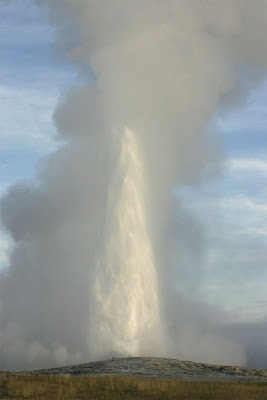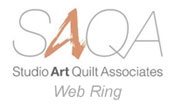In June I took Kerr Grabowski's Deconstructed Screen Printing class at QSDS. I have already posted some of the results,
here and
here. My friend
Linda in Belgium and I are having a conversation about this technique, our successes and less than desireables. I thought I would put my pictures on my blog and discuss them here rather than send them to her in an email. That way the rest of you can see what a cool process this is. I highly recommend the
DVD that Kerr has made. It's 3 1/2 hours long, costs $35, and takes you through the process from start to finish.
These are in no particular order and since when you do the upload it always puts the most recent pics at the top of the post, it's even more un-ordered. If I had planned better I would have started at the bottom of my upload folder, but I always forget about that. Most of the fabrics began as white with the color added during the screening process. If the fabric was already dyed a color, I mention that.
 Multiple screens were used to get this piece. Some had already been used previously and were nearly totally deconstructed and others were still unused. The screens were different sizes and there were many textures.
Multiple screens were used to get this piece. Some had already been used previously and were nearly totally deconstructed and others were still unused. The screens were different sizes and there were many textures.
 Closeup. I think those are confetti like pieces of paper making those cross hatch lines.
Closeup. I think those are confetti like pieces of paper making those cross hatch lines.
 Definitely a cut paper stencil making the tree shape.
Definitely a cut paper stencil making the tree shape.
 Texture only.
Texture only.
 Screened over a furnace filter. Release color is sort of yellow/green.
Screened over a furnace filter. Release color is sort of yellow/green.
 Screened with dye paste through a thermofax screen (the spiral shape), then drew little squares and rectangles with a curved tip syringe, all in a green color. The fabric was already dyed sort of gold; the release paste color is yellowish.
Screened with dye paste through a thermofax screen (the spiral shape), then drew little squares and rectangles with a curved tip syringe, all in a green color. The fabric was already dyed sort of gold; the release paste color is yellowish.
 Another view.
Another view.
 This is two different screens. The parallel lines are newspaper stencils. Behind that you can see the screen that I did over top of a stamp (see the original several pictures down the page).
This is two different screens. The parallel lines are newspaper stencils. Behind that you can see the screen that I did over top of a stamp (see the original several pictures down the page).
 This is what Kerr describes as ghost printing. I made the screen with a torn paper stencil, leaving lots of open space. For the first pull (on the right) I loaded the screen up with black thick dye and pulled the image. The second pull (immediately to its left) was done without adding any more thick dye, so only what was already on the screen. The third pull (again, move left) there is barely any dye left on the screen and all you see are the ghostly outlines of the stencil. The scribble lines are done later with the curved tip syringe. The fabric was already dyed gold.
This is what Kerr describes as ghost printing. I made the screen with a torn paper stencil, leaving lots of open space. For the first pull (on the right) I loaded the screen up with black thick dye and pulled the image. The second pull (immediately to its left) was done without adding any more thick dye, so only what was already on the screen. The third pull (again, move left) there is barely any dye left on the screen and all you see are the ghostly outlines of the stencil. The scribble lines are done later with the curved tip syringe. The fabric was already dyed gold.

The background screen was some kind of textural thing. The writing is the formula for urea water and thickened alginate. This was two separate screenings as I let the background batch before doing the writing part.
 Another view.
Another view.
 On this piece I put a stamp that I made under the screen, then pulled brown dye paste. Screened with uncolored release paste. At least I think that's what I did.
On this piece I put a stamp that I made under the screen, then pulled brown dye paste. Screened with uncolored release paste. At least I think that's what I did.
 A closer view.
A closer view.
 Torn paper stencil, screened with screen lying on top of kraft paper with red-brown dye paste. The kraft paper wrinkles up when it gets wet and gives that sort of bark-like texture.
Torn paper stencil, screened with screen lying on top of kraft paper with red-brown dye paste. The kraft paper wrinkles up when it gets wet and gives that sort of bark-like texture.
 The above piece is one of the few that I didn't like. I first drew a spiral and some dots on the screen with black thickened dye. After it dried, painted red and yellow thickened dye. After that dried, screened with alginate.
The above piece is one of the few that I didn't like. I first drew a spiral and some dots on the screen with black thickened dye. After it dried, painted red and yellow thickened dye. After that dried, screened with alginate.
 The screen was done with torn paper and a textured background. The background fabric was already dyed gold. Released with red thickened dye. The solid red areas are when the paper was removed from the back of the screen so that the red went through immediately.
The screen was done with torn paper and a textured background. The background fabric was already dyed gold. Released with red thickened dye. The solid red areas are when the paper was removed from the back of the screen so that the red went through immediately.
 I think orange dye paste went on the screen with some kind of texture. Then screened with yellow thick dye. As the orange deconstructed, more of the yellow shows.
I think orange dye paste went on the screen with some kind of texture. Then screened with yellow thick dye. As the orange deconstructed, more of the yellow shows.
 The screen has torn bits of paper as a stencil, then red dye paste was screened with the screen on top of a metalic grid to get the diagonal shapes. Screened with yellow thick dye.
The screen has torn bits of paper as a stencil, then red dye paste was screened with the screen on top of a metalic grid to get the diagonal shapes. Screened with yellow thick dye.

I drew a grid on the screen with thickened dye, I think in a dark red color. The fabric was dyed yellow and I screened with a brownish color.
 Then since there was still a fair amount of grid on the screen, I did a second piece of fabric. This piece of fabric was already dyed a sort of goldy-yellow. The release color I don't remember.
Then since there was still a fair amount of grid on the screen, I did a second piece of fabric. This piece of fabric was already dyed a sort of goldy-yellow. The release color I don't remember.



























